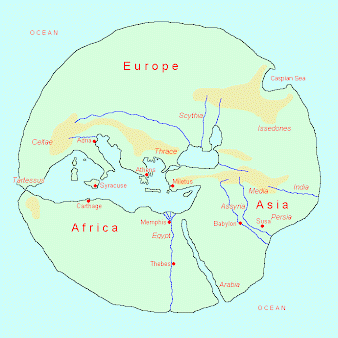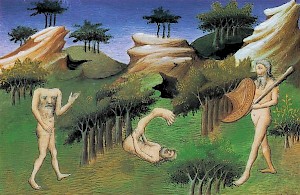The Edges of the Earth (2)
Edges of the earth: the parts of the world where, according to the myths of the ancient Greeks and Romans, fabulous creatures and savage barbarians lived. These legendary beliefs influenced geography and can still obstruct our understanding of ancient ethnography.

The map of Hecataeus of Miletus (c.550-c.490) can be seen as the first attempt to break away from the schematic approach described above. It is more or less correct as far as the Mediterranean is depicted, but Asia is much too small. Moreover, Hecataeus still considered the earth to be a flat dish with clearly defined edges.
The same can be said about the Greek researcher Herodotus of Halicarnassus (c.480-c.429), although he had a far better understanding of the shape of the world and may be called the father of geography. But although he criticized Hecataeus for "showing the Ocean running round a perfectly circular globe", Herodotus made similar mistakes. He accepted a clear distinction between the civilized Greeks in the center of the earth and the barbarians on the world's edges.

In his view, those savages did everything the other way round (e.g., the Egyptians; text). The same can be said for other things. Whereas Greece is poor in minerals, "it would seem to be a fact that the remotest parts of the world are the richest in minerals and produce the finest specimens of both animal and vegetable life" (text).
Of course, there were regions between the civilized world of the Greeks and the reversed world at the edges of the earth. This can be illustrated with the following example.
West of the seaport at the mouth of the Borysthenes (Dnieper) which lies in the middle of the Scythian coastline - the first people are the Graeco-Scythian tribe called Callipidae, and their neighbors to the eastward are the Alizones. Both these peoples resemble the Scythians in their way of life, and also grow grain for food, as well as onions, leeks, lentils, and millet.
North of the Alizones are agricultural Scythian tribes, growing grain not for food but for export.
Beyond these are the Neuri, and north of the Neuri the country, so far as we know, is uninhabited. [...]
Beyond [the uninhabited country] live the Maneaters - who have no connexion with the Scythians but are a quite distinct race.note
Here we can see clearly that, according to Herodotus, the world becomes stranger and stranger when one travels away from Greece, until one has reached the ends of the earth, where humans behave inhumanely.

Many Greek authors speculated about the people on the edges of the terrestrial disk. For example, Ctesias of Cnidus describes in his History of India people with dog's heads (cynoscephalae), people with one big foot, righteous Pygmies ("fist-men"), and the Martichora, a kind of tiger with a human face and three rows of teeth. In other texts, we encounter people with goat's legs, dwarfs, baldheads, yellow people, black people, werewolves, nudists. Some of these did really exist, others were the result of reversal, still others had their origins in the fantasy of the nation that also invented centaurs, gorgons, and cyclopes.
In the first century BCE, the geographer Strabo of Amasia developed a complete "inversion theory" about the barbarians on the edges of the world, which can be described as follows.
In the first place, civilized people -Strabo means: Greeks and Romans- live along rivers and on coastal plains. As a corollary, barbarians live in forests and mountainous regions. (The logical consequence is that the shores of the Ocean resemble fjords.) This geographical difference results in different modes of production. The country of the barbarians is poor and allows only animal husbandry; but on the fertile soils of civilized countries, arable farming is possible. Opposed to civilized, bread-eating people, stand nomadic barbarians, who live on a diet of meat and dairy.
The consequence is a different way of life. Greeks and Romans can live in towns (the Macedonian philosopher Aristotle of Stagira had once defined "man" as "an animal living in cities") and feel no need to carry weapons, because they are living in peace with their neighbors. They can use their spare time to relax and study. Barbarians, on the other hand, never remain on the same place for a long time. Together with their sheep and cows, they roam through the mountains. They have to be on their guard, because there are always cattle thieves; therefore, they are permanently under arms.
Strabo's civilized city-dwellers can live according to law and ethics, but the barbarians have neither law nor good customs. One of the most popular stereotypes in ancient literature is that barbarians do not respect the divine laws of hospitality, and eat their guests or serve them to their gods (cf. Herodotus' Maneaters above).
Obviously, good taste is confined to the cities surrounding the Mediterranean sea. There, people with nice hair cuts wear fine clothes, e.g. Greek chitons or Roman togas. On the edges of the earth, people have mustaches and are dressed - if they are dressed at all! - in trousers, the ultimate example of indecency.
According to Strabo, the barbarians are trapped in a vicious circle. Because they live in the wilderness, arable farming is impossible, and they are forced to live as poachers and marauders. If someone has the idea to start a farm, his hostile neighbors will force him to give it up. Under these circumstances, there is no room for civilization, and therefore, the barbarian is socially handicapped. He withdraws from anybody's company, and prefers to live in the wilderness.
So, there is no escape from his situation. Time and again, the barbarians are forced to fight. Therefore, they are fierce people, aggressive and virile. These savages lack any moral scruples: when they have concluded a treaty, they will ignore it as soon as they see an opportunity to pillage their neighbor's country. Because they are always fighting, they do not think. They prefer force to reason, have a simple way of behaving, and believe only in honor and courage.
Because barbarians never think, they can easily be manipulated. They love any enterprise that gives them an opportunity to show their courage. In general terms, they love change. They never stay on the same place, easily accept other leaders, ignore treaties, and do not know what marital fidelity is.
This is Strabo's theory of barbarism and civilization. Of course, they are extreme types: most people lived somewhere between absolute barbarism and absolute civilization. Besides, most Greek or Roman authors conceded that some barbarians were in fact noble savages (e.g., Spartacus and Julius Civilis, the leader of the Batavian revolt), and almost every writer warned for the dangers of civilization: decadence and effeminacy.
However, the stereotypical barbarian on the edges of the earth was always present in the minds of Greek and Roman authors. Everybody knew that in the remotest areas lived the most dangerous warriors. In the next part of this article, we will see how these ideas have influenced the description of one part of the world: the Low Countries, i.e., modern Belgium and Holland.